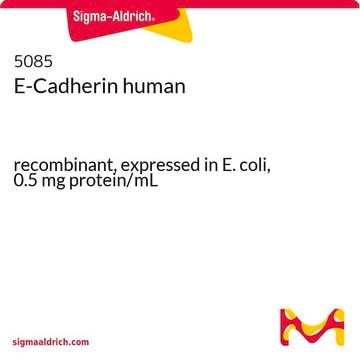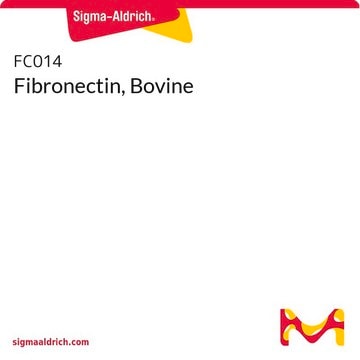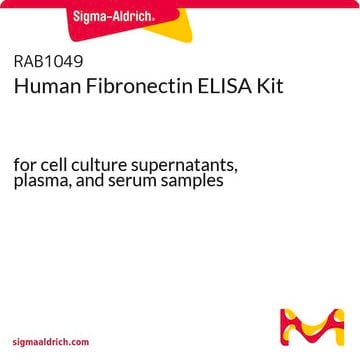ECM001
Human Fibronectin
recombinant, expressed in HEK 293 cells, powder, suitable for cell culture
Sinônimo(s):
Fibronectin, CIG, Cold-insoluble globulin, FN
About This Item
Produtos recomendados
product name
Fibronectina, recombinant, expressed in HEK 293 cells, lyophilized powder, suitable for cell culture
fonte biológica
human
Nível de qualidade
recombinante
expressed in HEK 293 cells
esterilidade
sterile
Ensaio
≥95% (SDS-PAGE)
forma
lyophilized powder
peso molecular
259.5 kDa (The protein migrates as a higher band on SDS-PAGE due to glycosylation.)
embalagem
pkg of 200 μg
técnica(s)
cell culture | mammalian: suitable
Impurezas
≤1 EU/μg endotoxin, tested
solubilidade
water: soluble
nº de adesão NCBI
nº de adesão UniProt
Condições de expedição
ambient
temperatura de armazenamento
−20°C
Informações sobre genes
human ... FN1(2335)
Procurando produtos similares? Visita Guia de comparação de produtos
Categorias relacionadas
Descrição geral
Aplicação
Recommended for use as a cell culture substratum at 1-5 μg/cm2 or 0.5-50 μg/ml. Optimal concentration depends on cell type as well as the application or research objectives.
Ações bioquímicas/fisiológicas
Características e benefícios
- Human-derived fibronectin
- Produced through recombinant expression in HEK 293 cells
- Low endotoxin levels
- Absence of bacterial contamination
forma física
Nota de análise
Código de classe de armazenamento
11 - Combustible Solids
Classe de risco de água (WGK)
WGK 3
Ponto de fulgor (°F)
Not applicable
Ponto de fulgor (°C)
Not applicable
Certificados de análise (COA)
Busque Certificados de análise (COA) digitando o Número do Lote do produto. Os números de lote e remessa podem ser encontrados no rótulo de um produto após a palavra “Lot” ou “Batch”.
Já possui este produto?
Encontre a documentação dos produtos que você adquiriu recentemente na biblioteca de documentos.
Os clientes também visualizaram
Artigos
The extracellular matrix (ECM) and its attachment factor components are discussed in this article in relation to their function in structural biology and their availability for in vitro applications.
The extracellular matrix (ECM) is secreted by cells and surrounds them in tissues.
Extracellular matrix proteins such as laminin, collagen, and fibronectin can be used as cell attachment substrates in cell culture.
Protocolos
Dilute fibronectin for cell attachment, varying per cell type. Coating protocol, products, and FAQs provided.
Nossa equipe de cientistas tem experiência em todas as áreas de pesquisa, incluindo Life Sciences, ciência de materiais, síntese química, cromatografia, química analítica e muitas outras.
Entre em contato com a assistência técnica









